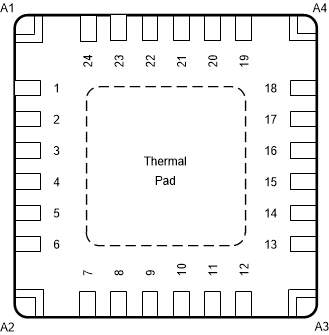ZHCSGI2E july 2017 – july 2023 TAS2505-Q1
PRODUCTION DATA
- 1
- 1 特性
- 2 应用
- 3 说明
- 4 Revision History
- 5 Pin Configuration and Functions
-
6 Specifications
- 6.1 Absolute Maximum Ratings
- 6.2 ESD Ratings
- 6.3 Recommended Operating Conditions
- 6.4 Thermal Information
- 6.5 Electrical Characteristics
- 6.6 I2S/LJF/RJF Timing in Master Mode
- 6.7 I2S/LJF/RJF Timing in Slave Mode
- 6.8 DSP Timing in Master Mode
- 6.9 DSP Timing in Slave Mode
- 6.10 I2C Interface Timing
- 6.11 SPI Interface Timing
- 6.12 Typical Characteristics
- 7 Parameter Measurement Information
-
8 Detailed Description
- 8.1 Overview
- 8.2 Functional Block Diagram
- 8.3 Feature Description
- 8.4 Device Functional Modes
- 8.5 Register Map
- 9 Application and Implementation
- 10Power Supply Recommendations
- 11Layout
- 12Device and Documentation Support
- 13Mechanical, Packaging, and Orderable Information
11.3 Thermal Pad
Solder the Thermal PAD to GND plane. The plane will work as heat sink. For details about the corner pads size and location, refer to the Section 13 at the end of this document.
 Figure 11-2 Thermal Pad Corner Locations
Figure 11-2 Thermal Pad Corner LocationsTable 11-1 Thermal Pad Corner
| CORNER | DESCRIPTION |
|---|---|
| A1 | Internally connected to thermal pad. Leave floating or connect to the same plane as thermal pad. |
| A2 | |
| A3 | |
| A4 |